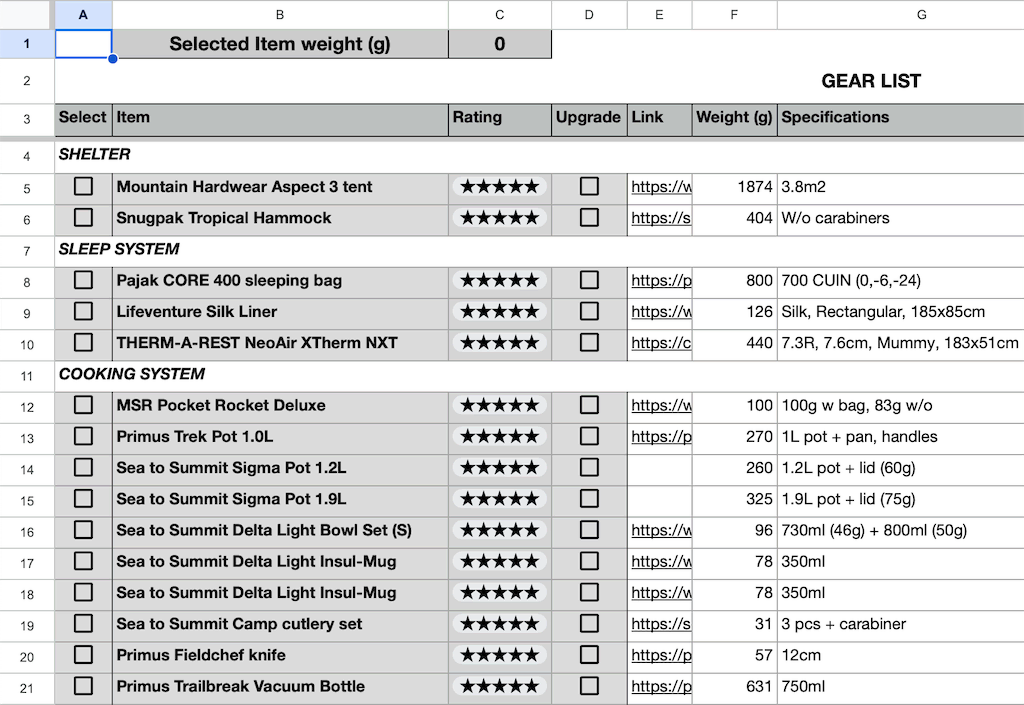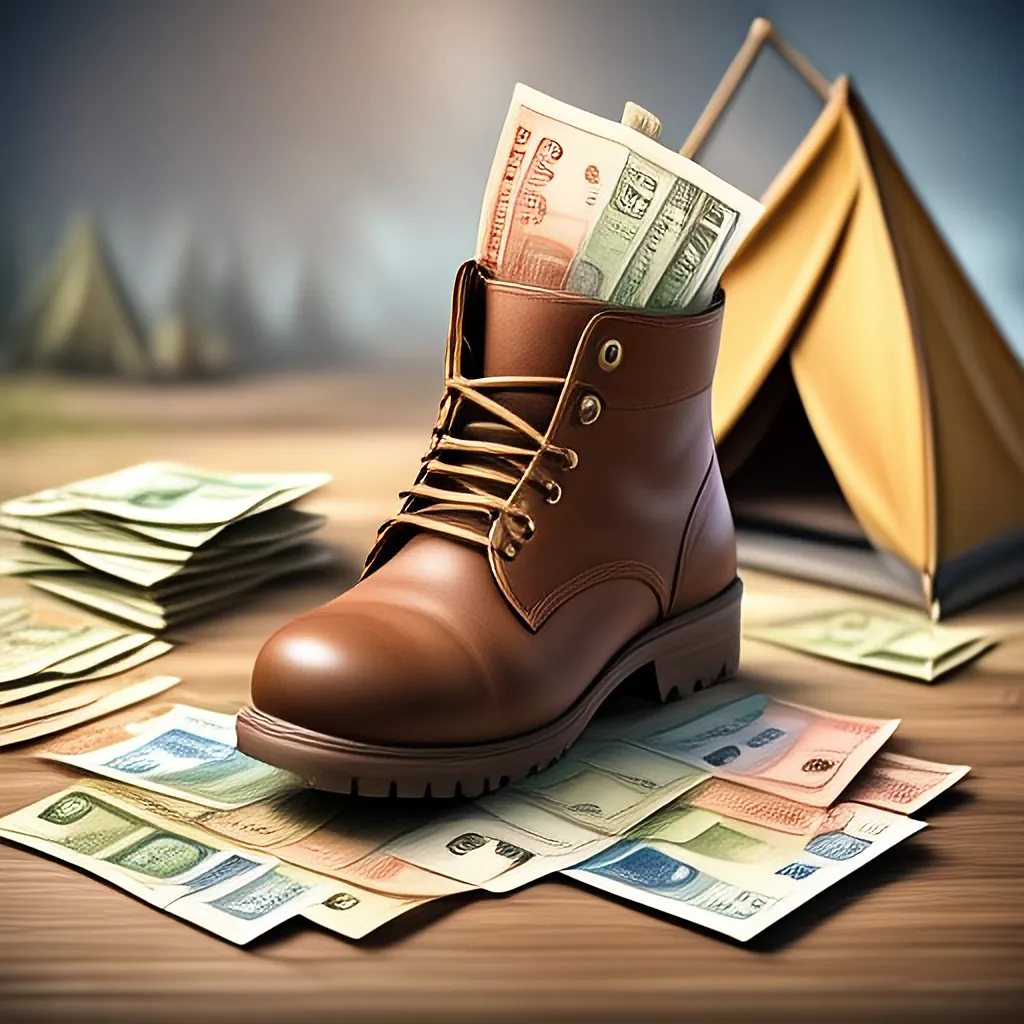Who doesn’t love gear? And who doesn’t love the thrill of buying new gear? You can easily get lost in an out of control spending spree, get bankrupt and have to sell your kidney while trying to catch-up with all the latest and best items of gear. But this issue is easy to overcome: like in most things in life, it’s all about setting boundaries. Just do it to yourself, in this case 🙂
By following these 5 rules of outdoor gear economics you’ll make sure to never feel bad about gear-related decisions, you’ll save money, and remain financially liquid (i.e. able to resell the items and return at least a major part of investment).
Rule #1: Make a list
As ridiculous as it sounds, but putting it all on paper, or, even better, in a spreadsheet – really helps to concentrate.
In a list you can more objectively evaluate what you actually need for the type of hikes, expeditions and camping you’ll be doing. You can list the items you have, mark the ones you would like to change or upgrade, and add everything which you are still missing. Avoid adding nice-to-have-yet-unnecessary items, as these usually increase expenses for minimal returns or benefits. If the item you suddenly desire so much is not on your list – don’t buy it.

This way you’ll know exactly what you need and know the estimated budget, while protecting yourself from buying unnecessary stuff.
Other perks of a spreadsheet is that you can have automated weight calculations for the specific gear you’re bringing to your next adventure, track your budget and savings, and have your personal review system where after some use you can flag the gear you’d like to upgrade.
- Feel free to use my draft spreadsheet with all the formulas already in place (copy the Sheet into your own GDrive and work on your own version). Short instructions on how to use it are inside.
- Pro tip: have a Wish List available for your friends and relatives and encourage them to gift you the items or retailer gift cards – these gifts become your free items in the list. It is much more honest than trying to get rid of that plate set you’ve got from your aunt on your birthday.
- For having a visual list of what mountaineering / climbing gear you own and what you wish for, I can wholeheartedly recommend WeighMyRack.
Rule #2: No rash purchases
Unless it’s a one-time-offer deal-of-the-century (over 50% cheaper than any other retailer), which miraculously fell upon you and you’ll be able to flip the item for considerable profit even if you won’t use it yourself, or don’t need it at the moment – don’t buy it. It’s the most simple rule of them all. Just don’t.
Rule #3: Research
Research what you want to buy first, what is best rated and recommended (ChatGPT might come in handy), then shortlist a few options, look for sales and discounts (account for shipping costs!), search in the secondhand market and make the most rational decision. A lot of gear can be bought slightly or never used at a fraction of the cost. And a lot of it can also be found on sale in various outlets. So research, compare and spend the least amount of your money for the best quality items.
- Rule #3.1: don’t buy stuff just because it’s cheap! Seriously. Unless the item is well revered by the community as a cheap alternative, and is from a reputable manufacturer – don’t buy it. Everything else loses value immediately and will be just a waste. I’m not saying that there aren’t any good cheap niche items – there definitely are. But the core of your gear portfolio should be made up of the best possible gear you can get. Quality and innovation costs.
Rule #4: don’t buy at MSRP
If it’s not a deal where you save money – have patience, there will be a better offer. The outdoor gear market is very dynamic, new products get released every day, so the item you’re hunting for will unavoidably get sold cheaper somewhere soon. Or something better, more efficient will come up. And you’ll still get a better deal. As a rule of thumb, try to buy at least at a -30% of the MSRP, the lower – the better. This is quite hard to achieve without planning in advance for what you actually need, that is why Rule #1 (Make a list) is there to save you.
I rarely buy anything over -25% of the MSRP, my total average savings are 47%, which means that if I’d decide to sell it all off – I’d make a profit, or at least return what I’ve spent on most of the items. And that’s the goal. Stay liquid.
- In Europe it’s a good practice to use idealo.de for general price research/comparison. I often end up buying stuff from German shops (bigger competition usually means better prices). But always check your local providers too, as they tend to have 1-2 massive stock sales per year, and most smaller items tend to be competitively priced everywhere.
- Don’t forget the club memberships you have – they usually have some agreements for discounts with local shops.
Rule #5: No regrets
In the end, you should be happy with everything you have bought. Even if it doesn’t live up to the expectations, even if you found a better deal the next day (that will always happen, so just make peace with it), overspent or feel like you made a mistake in your choice – you should forget about it all and live at peace with yourself after pressing the checkout button. In the end it’s just stuff. And if it doesn’t make you happy – don’t blame it. It’s not supposed to. Only you are responsible for your happiness. And as with any other stuff – you can just sell it, gift it or donate it, and move on to something which suits you better. And all the rules before this one will empower you to do exactly that.
All of this might sound, nerdy, funny and over-redundant (maybe even slightly obsessed), but by following these rules you’ll be able to upgrade your gear at a very low, or even zero cost to yourself indefinitely. And you won’t feel like you’ve drowned a lot of money into something you’re very passionate today, but might completely change your mind tomorrow. You have a liquid portfolio to sell off in such case.
So make financially healthy choices!
And follow for more weird advice in the future!
